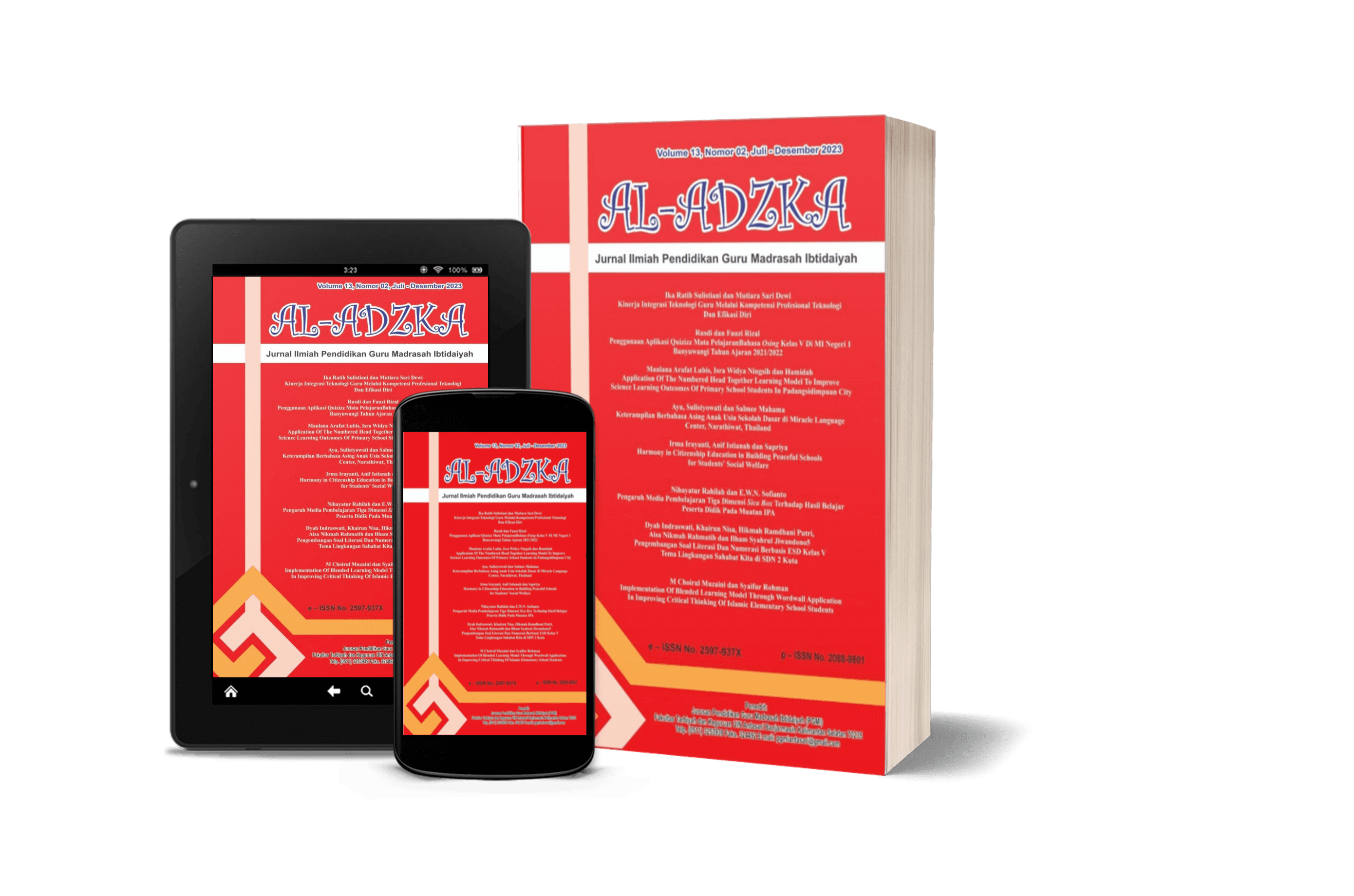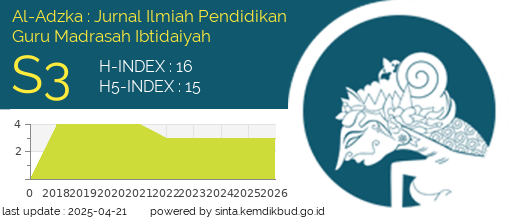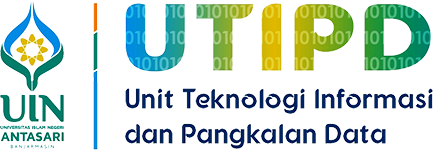The Development of Augmented Reality (Ar) Based Science Learning Media at MI Yaa Bunayya
DOI:
https://doi.org/10.18592/aladzkapgmi.v12i2.7274Keywords:
augmented reality, learning media, researh of development, science-subjectAbstract
This study aims to produce an Augmented Reality (AR)-based learning media in the science field at MI Yaa Bunayya. The development method in this study uses a modified Thiagarajan 4D model with three stages (Define, Design, and Develop). The Augmented Reality (AR) learning media, later named the SANDIR Application, was assessed by the reviewer and 10 class V students of MI Yaa Bunayya to find student responses. The instrument used is a checklist questionnaire. The data obtained is in the form of qualitative data which is converted into quantitative, analyzed descriptively to determine the quality of the product. The results showed that the SANDIR Application learning media for science subjects that had been developed was based on reviewers' assessments with an average score of 33.7, classified as very good (SB). SANDIR application learning media based on student responses has a percentage of 99.13 with a positive value category in helping students' understanding while learning and is included in the very good quality category. Based on the data acquisition results, the SANDIR Application learning media is in accordance with the cognitive development of elementary school-aged children and is suitable for use as a learning resource for fifth grade students of elementary school.References
Alhaija, H. A. (2018). Augmented Reality Meets Computer Vision: Efficient Data Generation for Urban Driving Scenes. International Journal of Computer Vision, 126(9), 961–972. https://doi.org/10.1007/s11263-018-1070-x
Asiah, S. (2014). Penerapan Metode Out Door Activity dalam Pembelajaran IPA Untuk Meningkatkan Hasil Belajar Siswa Sekolah Dasar. 02, 11.
Aswani, A., & Aswani, A. (2022). Efektivitas dan Kesulitan Belajar Online Terhadap Antusiasme Siswa dalam Belajar. Jurnal Ilmiah KORPUS, Query date: 2022-11-15 13:00:38. https://ejournal.unib.ac.id/korpus/article/view/22784
Atmajaya, D. (2017). Implementasi Augmented Reality untuk Pembelajaran Interaktif. ILKOM Jurnal Ilmiah, 9(2), 227–232. https://doi.org/10.33096/ilkom.v9i2.143.227-232
Awani, M., Noviana, E., & ... (2022). Identifikasi Kesulitan Belajar Online Di Masa Pandemi Covid-19: Studi Kasus Pada Mahasiswa PGSD. Jurnal Pajar (Pendidikan …, Query date: 2022-11-15 13:00:38. https://pajar.ejournal.unri.ac.id/index.php/PJR/article/view/8829
Bahar, Y., N. (2014). Aplikasi Teknologi Virtual Realty Bagi Pelestarian Bangunan Arsitektur. Jurnal Desain Konstruksi, 13(2).
Blanco-Novoa, O. (2018). A Practical Evaluation of Commercial Industrial Augmented Reality Systems in an Industry 4.0 Shipyard. IEEE Access, 6(Query date: 2022-09-01 15:16:57), 8201–8218. https://doi.org/10.1109/ACCESS.2018.2802699
Bottani, E. (2019). Augmented reality technology in the manufacturing industry: A review of the last decade. IISE Transactions, 51(3), 284–310. https://doi.org/10.1080/24725854.2018.1493244
Boud, A. C., Haniff, D. J., Baber, C., & Steiner, S. J. (1999). Virtual reality and augmented reality as a training tool for assembly tasks. 1999 IEEE International Conference on Information Visualization (Cat. No. PR00210), 32–36. https://doi.org/10.1109/IV.1999.781532
Chen, P. H. C. (2019). An augmented reality microscope with real-time artificial intelligence integration for cancer diagnosis. Nature Medicine, 25(9), 1453–1457. https://doi.org/10.1038/s41591-019-0539-7
Chusna, A., Setiadi, A., Amalia, E., & ... (2021). Studi Literatur Penerapan Augmented Reality dalam Pembelajaran Kimia: Keunggulan, Manfaat dan Aplikasinya. Lomba Karya Tulis …, Query date: 2022-11-15 13:20:18. https://journal.ittelkom-sby.ac.id/lkti/article/view/149
Delgado, J. M. D. (2020). A research agenda for augmented and virtual reality in architecture, engineering and construction. Advanced Engineering Informatics, 45(Query date: 2022-09-01 15:16:57). https://doi.org/10.1016/j.aei.2020.101122
Dey, A. (2018). A systematic review of 10 Years of Augmented Reality usability studies: 2005 to 2014. Frontiers Robotics AI, 5(Query date: 2022-09-01 15:16:57). https://doi.org/10.3389/frobt.2018.00037
Dieck, M. C. tom. (2018). A theoretical model of mobile augmented reality acceptance in urban heritage tourism. Current Issues in Tourism, 21(2), 154–174. https://doi.org/10.1080/13683500.2015.1070801
Diskominfo. (2022). Diskominfo Papua Agendakan Kegiatan Literasi Digital di Yapen dan Sarmi. https://papua.go.id/view-detail-berita-8146/diskominfo-papua-agendakan-kegiatan-literasi-digital-di-yapen-dan-sarmi.html
Fabio Costa. (2020). Siswa di Papua Kian Sulit Dapatkan Akses Pendidikan Selama Pandemi Covid-19. https://www.kompas.id/baca/dikbud/2020/06/04/siswa-di-papua-kian-sulit-dapatkan-akses-pendidikan-selama-pandemi-covid-19
Fraga-Lamas, P. (2018). A Review on Industrial Augmented Reality Systems for the Industry 4.0 Shipyard. IEEE Access, 6(Query date: 2022-09-01 15:16:57), 13358–13375. https://doi.org/10.1109/ACCESS.2018.2808326
Harini, E., & Pujiriyanto, P. (2022). Analisis Manfaat Pengintegrasian Augmented Reality pada Bahan Ajar Pembelajaran Tingkat Sekolah Dasar. Epistema, Query date: 2022-11-15 13:20:18. https://journal.uny.ac.id/index.php/epistema/article/view/50570
Heller, J. (2021). Tangible Service Automation: Decomposing the Technology-Enabled Engagement Process (TEEP) for Augmented Reality. Journal of Service Research, 24(1), 84–103. https://doi.org/10.1177/1094670520933692
Hendrik Rikarsyo Rewapatara. (2022). Diskominfo Papua Agendakan Literasi Digital di Dua Kabupaten: Selektif Memilih Informasi—Tribun-papua.com. https://papua.tribunnews.com/2022/10/10/diskominfo-papua-agendakan-literasi-digital-di-dua-kabupaten-selektif-memilih-informasi
Huzaimah, P. Z., & Amelia, R. (2021). Hambatan yang Dialami Siswa Dalam Pembelajaran Daring Matematika Pada Masa Pandemi COVID-19. Jurnal Pendidikan Matematika, 05(01), 9.
Iwanaga, J. (2021). A review of anatomy education during and after the COVID-19 pandemic: Revisiting traditional and modern methods to achieve future innovation. Clinical Anatomy, 34(1), 108–114. https://doi.org/10.1002/ca.23655
KEMENKOMINFO. (2022). Kemenkominfo Bekali Pemuda Papua Tentang Manfaat Teknologi Digital | Pemerintah Daerah Kabupaten Merauke. https://portal.merauke.go.id/news/6090/kemenkominfo-bekali-pemuda-papua-tentang-manfaat-teknologi-digital.html
Kurnia, R., Wahyuni, B., Handayani, N., & ... (2022). Analisis Kesulitan Belajar Matematika Siswa dalam Pembelajaran Daring (Online) di Masa Pandemi Covid-19. Integral: Pendidikan …, Query date: 2022-11-15 13:00:38. https://e-journal.umc.ac.id/index.php/JNR/article/view/3107
Osadchyi, V. V. (2021). Using augmented reality technologies for STEM education organization. Journal of Physics: Conference Series, 1840(1). https://doi.org/10.1088/1742-6596/1840/1/012027
Palmarini, R. (2018). A systematic review of augmented reality applications in maintenance. Robotics and Computer-Integrated Manufacturing, 49(Query date: 2022-09-01 15:16:57), 215–228. https://doi.org/10.1016/j.rcim.2017.06.002
Peng, H. (2018). Roma: Interactive fabrication with augmented reality and a Robotic 3D printer. Conference on Human Factors in Computing Systems - Proceedings, 2018(Query date: 2022-09-01 15:16:57). https://doi.org/10.1145/3173574.3174153
Permana, A. (2021). Pembuatan Ebook dan Augmented Reality Manfaat Buah dan Sayur sebagai Media Pembelajaran bagi Anak SD. ereport.ipb.ac.id. http://ereport.ipb.ac.id/id/eprint/8328/1/J3C118126-01-adi-cover.pdf
Rauschnabel, P. A. (2022). What is XR? Towards a Framework for Augmented and Virtual Reality. Computers in Human Behavior, 133(Query date: 2022-11-15 12:19:28). https://doi.org/10.1016/j.chb.2022.107289
Reipschlager, P. (2021). Personal augmented reality for information visualization on large interactive displays. IEEE Transactions on Visualization and Computer Graphics, 27(2), 1182–1192. https://doi.org/10.1109/TVCG.2020.3030460
Sadiah, T. (2022). Kesulitan Pendampingan Belajar Online Siswa SD Pada Masa Pandemi Covid-19. Prosiding Konferensi Nasional, Query date: 2022-11-15 13:00:38. https://journal.ubpkarawang.ac.id/index.php/ProsidingKNPP/article/view/2585
Sanou, B. (2015). Measuring the Information Society Report 2015 Executive Summary. 56.
Tim Puslitjaknov. (2008). Metode Penelitian dan Pengembangan. Jakarta: Pusat Penelitian Kebijakan dan Inovasi Pendidikan Badan Penelitian dan Pengembangan Depdiknas.
Tkachuk, V. (2021). Using Mobile ICT for Online Learning During COVID-19 Lockdown. Communications in Computer and Information Science, 1308(Query date: 2022-11-15 12:19:28), 46–67. https://doi.org/10.1007/978-3-030-77592-6_3
Trianto. (2013). Mendisain Model Pembelajaran Inovasi Progesif “Konsep, Landasan, dan Implementasinya pada Kurikulum Tingkat Satuan Pendidikan (KTSP).” Jakarta: Kencana Prenada Media Group.
Turmuzi, M., Dasing, A., Baidowi, B., & ... (2021). Analisis kesulitan belajar mahasiswa secara online (e-learning) selama masa pandemi COVID-19. Edukatif: Jurnal Ilmu …, Query date: 2022-11-15 13:00:38. https://www.edukatif.org/index.php/edukatif/article/view/482
Utami, S. (2018). Penggunaan Media Gambar untuk Meningkatkan Motivasi dan Hasil Belajar IPA Siswa Kelas III Sekolah Dasar. Primary: Jurnal Pendidikan Guru Sekolah Dasar, 7(1), 137. https://doi.org/10.33578/jpfkip.v7i1.5346
Verawati, V., & Ni’mah, N. (2022). Kesulitan Mahasiswa Selama Pembelajaran Online dan Pengaruhnya Terhadap Hasil Belajar di Era New Normal. VOX EDUKASI: Jurnal Ilmiah Ilmu …, Query date: 2022-11-15 13:00:38. http://jurnal.stkippersada.ac.id/jurnal/index.php/VOX/article/view/1385
Yeung, A. W. K. (2021). Virtual and augmented reality applications in medicine: Analysis of the scientific literature. Journal of Medical Internet Research, 23(2). https://doi.org/10.2196/25499
Zhan, T. (2020). Augmented Reality and Virtual Reality Displays: Perspectives and Challenges. iScience, 23(8). https://doi.org/10.1016/j.isci.2020.101397
Downloads
Published
How to Cite
Issue
Section
License
Copyright (c) 2022 Fajar Dwi Mukti

This work is licensed under a Creative Commons Attribution 4.0 International License.
Authors who publish with this journal agree to the following terms:
- Authors retain copyright and grant the journal right of first publication with the work simultaneously licensed under a Creative Commons Attribution 4.0 International that allows others to share the work with an acknowledgement of the work's authorship and initial publication in this journal.
- Authors are able to enter into separate, additional contractual arrangements for the non-exclusive distribution of the journal's published version of the work (e.g., post it to an institutional repository or publish it in a book), with an acknowledgement of its initial publication in this journal.
- Authors are permitted and encouraged to post their work online (e.g., in institutional repositories or on their website) prior to and during the submission process, as it can lead to productive exchanges, as well as earlier and greater citation of published work.












